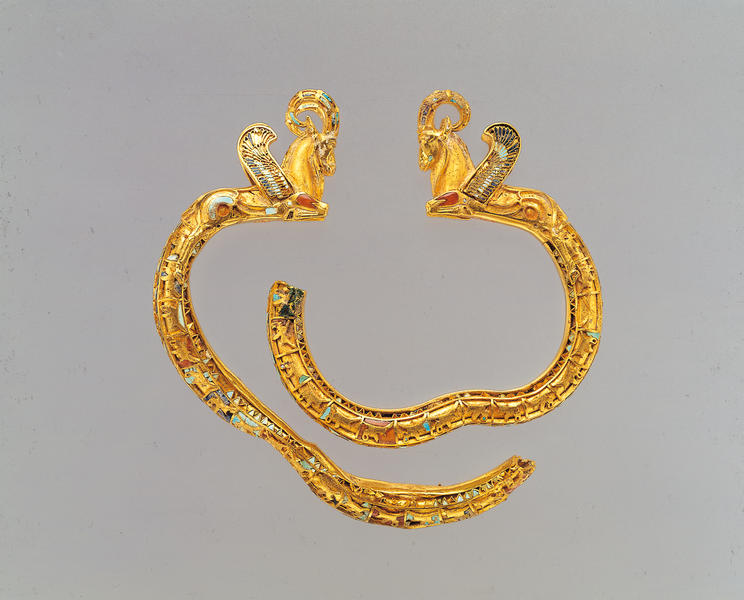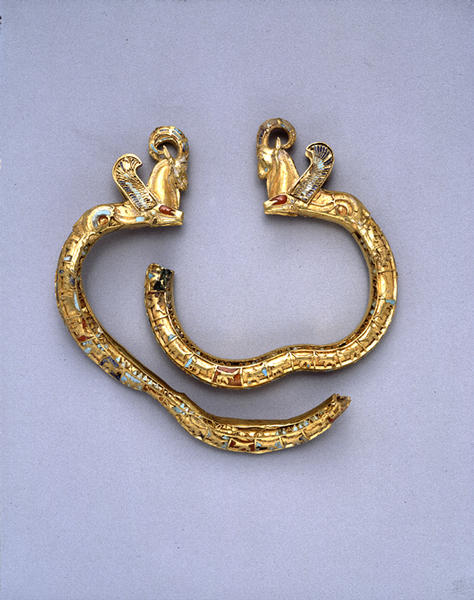Pair of Bracelets with Winged-caprid Terminals
- Iran
- Persia, Achaemenid period
- Mid-6th to 4th centuries B.C.
- Gold, cloisonne inlay of lapis lazuli, carnelian
- H-11.2 W-11.1
Catalogue Entry
These two magnificent bracelets are said to have originally belonged with the torque (cat. no. 38) and should likewise be attributed to the late Achaemenid period.1 An association of these pieces is corroborated by stylistic and technical similarities.
The bracelets are composed of separately made gold elements, such as the caprid terminals, and hollow gold tubing, and they incorporate intricate cloisonn decoration and bands of triangular teeth, which are often seen on representations of Achaemenid robes.2 Each bracelet was originally adorned with two opposing winged caprids (goat- or sheep-like animals), a familiar motif of Achaemenid art, and which recurs in miniature on friezes on the circlets. Although heavily damaged, the surviving terminals still display the forceful and monumental court style of the Achaemenid Empire. Most of the ornamental contours of the muscles and other anatomical details such as the horns, eyes, or wings were once abundantly inlayed with colorful stones and glass paste, underlining the almost supernatural impression of the fabulous creatures.
The bracelets, with typical omega-shaped indentations (compare cat. no. 42) and complete animals instead of simple protomes (foreparts), follow the familiar typology of Achaemenid bracelets.3 The motif of running caprids was very popular in Achaemenid art. These creatures, in most cases winged, are all likelihood tragelaphoi, fabulous Persian caprids mentioned several times in Greek literature and compared by Plato with the sphinx of the Egyptians.4 They are depicted on items ranging from gems5 to precious vessels6 and even to the famous golden chariot that was constructed to carry Alexander's embalmed corpse from Babylon to the Mediterranean.7 Especially in connection with Alexander the Great, tragelaphoi seem to be linked to royal splendor, a concept that would correlate very well with the possibility that the torque and bracelets of this quality and iconography could have been royal gifts.
MP
1. As a comparison in style and technique see the well-known bracelets in London, British Museum 124017: Dalton 1969, pp. 32-34, no. 116, fig. 64, pl. 1; Pfrommer 1990b, pp. 121-24, 291, TA 116, fig. 16.3.
2. See for example Pfrommer 1997.
3. For comparative bracelets with complete animals of various kinds see Pfrommer 1990b, pp. 118-21. For the indentation see ibid., p. 99.
4. See, for example, Plato, Politeia IV.488 a; Athenaios XI.484 c (s.v. Labronia), XI.500 d, e (s.v. Tragelaphos). The sources will be discussed in another context.
5. As parallels for the running caprids on the circlets see [author TK 1908, p. 169, fig. 9.
6. See the famous pair of handles in Paris, Louvre AO 2748, and in Berlin, Staatliche Museen preu゜ischer Kulturbesitz, Antikenabteilung Misc. 8180: Amandry 1958, pp. 50-51, pls. 26.2; 27.2-.3; 28.4; Pfrommer 1990a, p. 198, fig. 4. Rhyton with protome of a tragelaphos from the "Seven Brother-kurgan IV," St. Petersburg, Hermitage SBr IV-3: Artamonow 1968, p. 35, pls. 117, 119.
7. Diodorus XVIII.26, 5.

